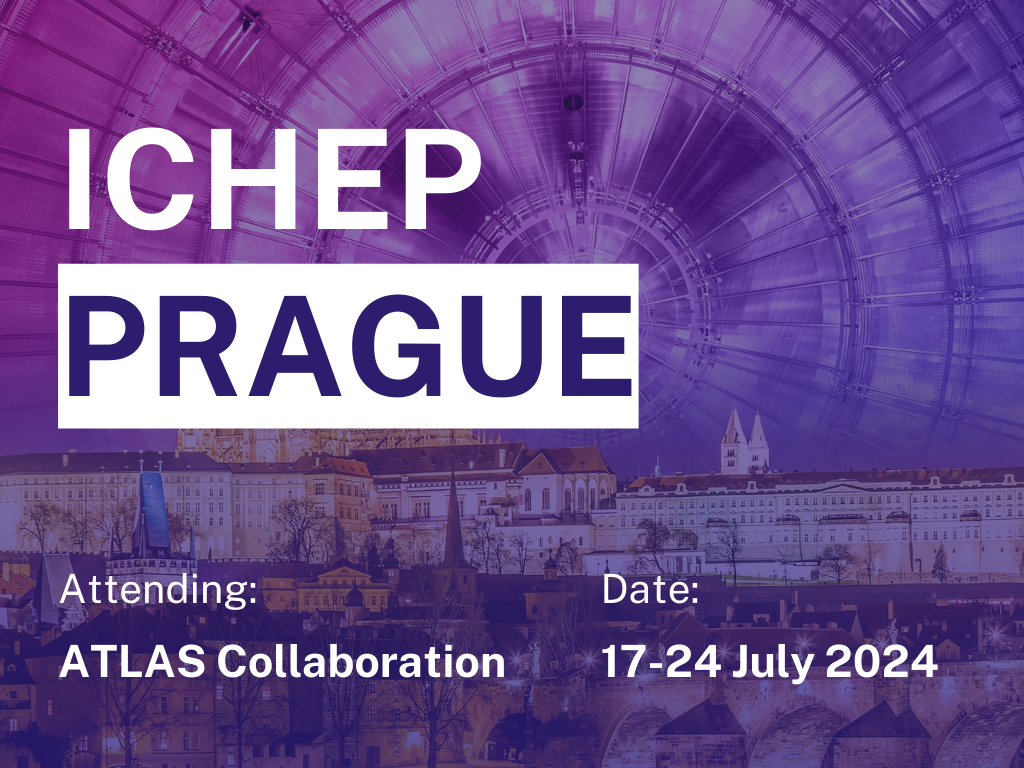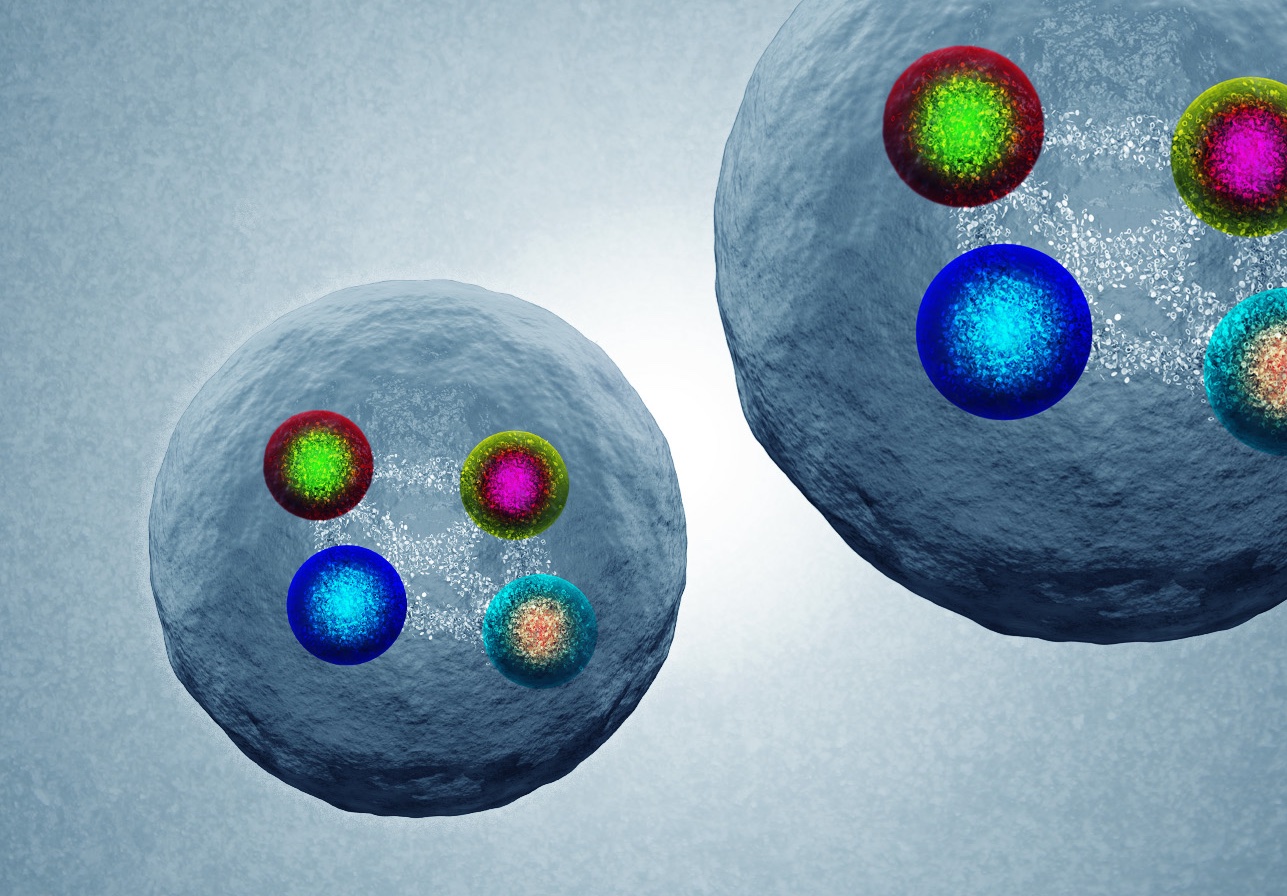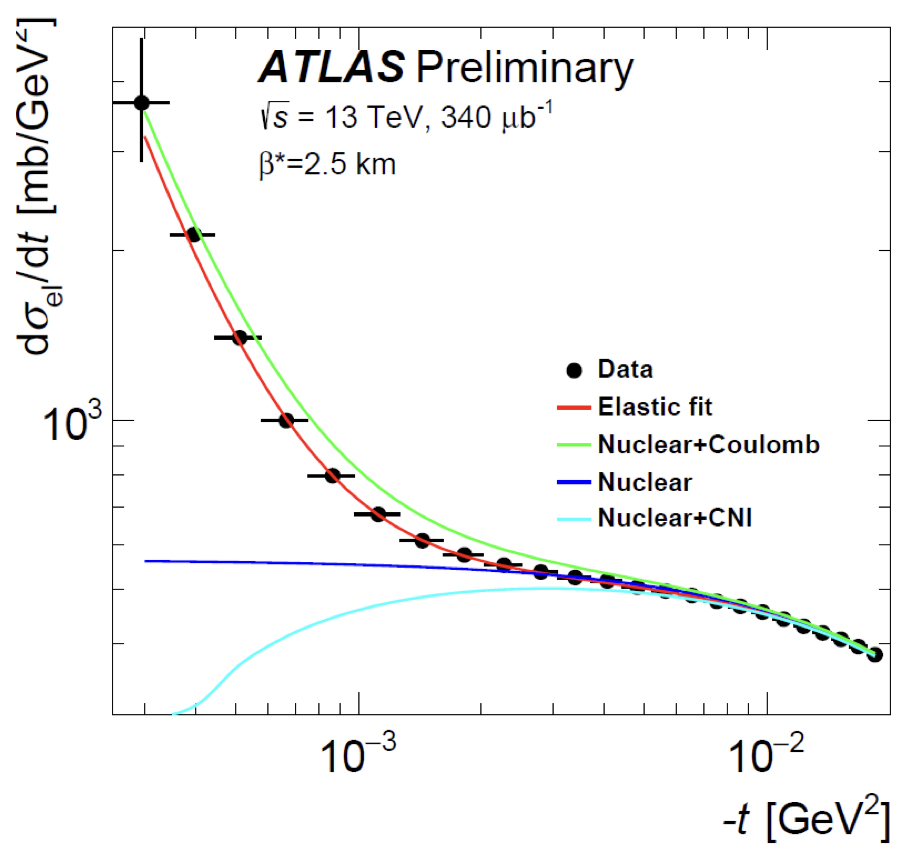ATLAS Highlights from ICHEP 2022
22 July 2022 | By

The bi-annual ICHEP conference is a can’t-miss in every high energy physics conference calendar. It is one of the biggest conferences of the community and brings together particle physicists from collider, neutrino, dark matter and astroparticle experiments, as well as colleagues from theory. The conference schedule not only includes the latest results of the many exciting particle physics experiments but also reserves time to discuss detector developments, machine learning applications, industry collaborations, outreach, and diversity and inclusion. This year marked a return to an in-person conference format while also enabling online participation for colleagues in other parts of the world. More than 1000 physicists made their way to Bologna (Italy) for the 41st edition of the conference, which took place from 6 to 13 July 2022.
The ATLAS Collaboration published 30 new results spanning from Higgs boson and Standard Model measurements to searches for new phenomena. These new analyses, together with other recent studies, were presented in detail by ATLAS members in 71 parallel session talks and 59 posters. The presented results are based on the dataset collected during Run 2 of the LHC (2015-2018) at a proton-proton collision energy of 13 TeV. In addition, researchers shared the first detector performance results from Run 3 of the LHC, which began on 5 July 2022.
10 years of Higgs boson physics
The ICHEP conference took place during a memorable week for particle physics, which kicked off with a 10th anniversary celebration of the Higgs boson discovery. Rising to the occasion, the ATLAS Collaboration published its most comprehensive and precise map of the Higgs boson’s properties and interactions with fundamental particles. This was presented and discussed at the ICHEP conference.
The mass of the Higgs boson is a free parameter in the Standard Model; its measurement is crucial for predicting the ways the Higgs boson can decay and be produced. The ATLAS Collaboration has measured the Higgs boson mass with unprecedented precision. For their result, physicists studied Higgs boson decays to a pair of Z bosons, which in turn decay each into a pair of electrons or muons. Thanks to efforts improving the determination of the muon momentum and data analysis techniques, the Higgs boson mass was measured to be 124.99 GeV with a precision of 0.15%. This is in good agreement with previous measurements.

The ATLAS Collaboration combined a plethora of measurements to paint its most detailed picture of Higgs boson interactions with other fundamental particles. These interactions can be studied by looking at the Higgs boson's multiple production and decay modes. Some particles, e.g. the W or Z boson, can interact directly with the Higgs boson in either its production or decay. Others can also interact indirectly, in production modes that contain intermediate particle states (“virtual loops”). Thus the combination of all dedicated measurements provides an even higher precision on interactions of the Higgs boson than the individual measurements, which target a specific production or decay mode. For their new result, ATLAS physicists combined measurements of the Higgs boson production via gluon fusion, vector-boson fusion, and associated with a top quark or weak-force boson (W or Z). They also probed Higgs boson decays to pairs of W or Z bosons, photons, tau leptons, bottom or charm quarks, muons, and a Z boson with a photon.
Physicists found that the measured amount of observed Higgs boson events agrees with the Standard Model expectation. The precision of their measurement is 6%, which corresponds to a 30% improvement with regards to the previous combination of Higgs boson measurements. This combined result provides further evidence that the interaction strength of a given particle to the Higgs boson is proportional to the particle’s mass as shown in Figure 1. This is a fundamental underlying assumption of particle mass generation via the Higgs mechanism. Researchers also examined the event kinematics when a Higgs boson is produced – looking at, for example, the transverse momentum or the number of additional “jets” of particles. This provides crucial knowledge about the fundamental processes at play during Higgs boson production, and could reveal contributions of unknown new physics processes that only indirectly and/or subtly impact Higgs boson production. No significant deviations from the Standard Model expectation were found.
The ATLAS Collaboration published its most comprehensive and precise map of the Higgs boson’s properties and interactions with fundamental particles.
Finally, the ATLAS Collaboration set the most stringent constraint on the rare production of Higgs boson pairs. This is a way of studying the self-interaction of the Higgs boson. It is directly connected to the shape of the Higgs potential and its measurement can improve our understanding of the earliest stages of the Universe and its stability. To make the most precise measurement of the di-Higgs production rate, physicists combined measurements of di-Higgs decays to four bottom quarks, two bottom quarks and two tau leptons, and two bottom quarks and two photons. The ATLAS Run-2 dataset contains only several thousand di-Higgs events, which is not enough to make a statistically significant measurement of this process. Instead, researchers set the most stringent limit on the di-Higgs production rate of not exceeding 2.4 times the Standard Model expectation, with a 95% confidence level. In addition, they improved the constraints on the Higgs self-coupling strength by 30%, narrowing the window for unexpected shapes of the Higgs potential. These results were enabled by improvements in selecting these rare di-Higgs events among the much more common Standard Model processes with similar signatures.
First observation of longitudinally-polarised W and Z bosons
The W and Z bosons, carriers of the weak force, have a substantial mass as a consequence of the Higgs mechanism. Thus, studies of their interactions provide a crucial probe of fundamental mechanisms of the Universe. One of the properties that gives insight into multi-boson interactions is their polarisation: the alignment of their spin with a given direction. Since W and Z bosons are massive, they can have both transverse and longitudinal (with respect to their direction of motion) polarisation components. Measurements of their joint polarisation in multi-boson production might also reveal effects of new physics.
However, multi-boson interactions are rare and the joint longitudinal polarisation of W and Z bosons accounts for only 7% of all WZ events. Nevertheless, the large dataset collected by the ATLAS experiment and sophisticated analysis techniques such as machine learning algorithms made it possible for researchers to observe the simultaneous longitudinal polarisation of both a W and Z boson for the first time. Physicists first presented this new observation at the ICHEP conference. They studied Z bosons decaying to electrons or muons, and W bosons decaying to an electron or muon and a neutrino. By constructing angular observables from the reconstructed decay products, they were able to determine the polarisation states of the initial W and Z bosons. Researchers also found a correlation between the polarisation states of the W and Z boson if produced simultaneously, by showing a different rate of longitudinal polarisation compared to polarisation states measured in the production of a single W or Z boson.

Charmonium tetraquarks
Quarks – a family of fundamental particles – are the building blocks of atomic nuclei. The strong force, an attractive force which acts on them, causes them to form bound states such as protons and neutrons. Only bound states of two or three quarks were known until recently, as experiments began reporting measurements of four-quark bound states called tetraquarks.
At the ICHEP conference, ATLAS researchers presented their first observation of states compatible with tetraquarks. Their measurement indicates that these tetraquark states consist of four charm quarks and have masses of around 7 GeV as shown in Figure 2. To obtain this result, physicists reconstructed the resonant tetraquark mass from their decays to four muons and profited from the advances in recording events with low momentum muons, which were specifically developed for studying bound states of quarks at low masses.
The results achieved with the large Run-2 dataset have significantly widened our knowledge about some of the most fundamental processes of the Universe.
Searches for new phenomena

Although the Standard Model describes many particles and their interactions incredibly well, there are certain phenomena that it cannot explain – such as the existence of dark matter or the abundance of matter over antimatter in the Universe. These mysteries could be explained through the existence of new particles, which may be produced in LHC collisions. ATLAS physicists are performing direct searches for these particles via their potential decay to or interaction with fundamental particles. This is an important pillar of ATLAS’ research programme and new results of many direct searches were presented at the ICHEP conference.
One group of such measurements looks for dark-matter particles. Dark-matter particles do not interact with the ATLAS detector and are thus “invisible”. Researchers can exploit this feature by searching for irregular patterns in events that indicate the presence of an undetected particle. In one new search looking at events with a single top-quark decay, physicists used the principle of momentum conservation and looked for transverse momentum imbalances. This would indicate momentum being carried away by undetected particles. Another search looked for dark-matter particles with significant lifetimes, which would travel up to 20 cm after being produced without being detected. They would then produce a Higgs or Z boson, which subsequently decays into photons or electrons, respectively. Therefore, this measurement looked for photons or electrons originating from an interaction point that is significantly displaced with regards to the proton-proton collision point. Neither dark-matter search revealed any significant deviations from the Standard Model expectation. In turn, physicists set limits, assuming certain models, on the minimum mass and maximum lifetime of potential dark-matter particles.
New results searching for symmetry-violating processes were also presented at ICHEP. These measurements look for events with an uneven amount of particles of a given type. So far, experiments have only observed the production of pairs with one matter and one antimatter particle. Some new theories explaining the Universe’s matter–antimatter asymmetry predict this production symmetry could be broken. This might be seen in hypothetical “leptoquarks”, which would decay to a quark and a lepton. Most leptoquark searches focus on decays to a quark and a lepton of the same "generation". In a new search, ATLAS researchers instead targeted leptoquark decaying into particles of different generations: into a top quark (a third-generation particle) and a muon or electron (second and first-generation particles, respectively). No deviation from the Standard Model expectation was found.
Another search for flavour-violating processes considered theories that extend the Higgs sector with additional, not-yet-discovered Higgs bosons. ATLAS physicists looked for signs of a new heavy boson decaying into at least one top quark and another quark. A mild excess of 2.8 standard deviations compared to the background-only hypothesis was found that would be consistent with a new, heavy Higgs boson with a mass of 1 TeV as shown in Figure 3. This excess is not significant enough to mark the discovery of new physics and more data have to be collected to make a confident statement on the existence or non-existence of such a particle.
Start of a new data-taking campaign
The results achieved with the large Run-2 dataset have significantly widened our knowledge about some of the most fundamental processes of the Universe. To study even rarer processes and search for even heavier unknown particles, more data at a higher collision energy are necessary. Tuesday 5 July marked the start of a new data-taking campaign at a world-record collision energy of 13.6 TeV, see Figure 4. The ICHEP conference saw many first looks at the data recorded at this collision energy, confirming the high-level performance of the ATLAS detector. The collaboration is looking forward to another successful era of data-taking and subsequent exciting physics results over the coming years!

Learn more
- Summary of new ATLAS results from ICHEP 2022, ATLAS News, 6 July
- 10 years of discovery with the Higgs boson, Press Statement, 4 July
- ATLAS Experiment records “first physics” at new high-energy frontier, Press Statement, 5 July
- ATLAS and CMS release results of most comprehensive studies yet of Higgs boson’s properties, CERN News, 4 July
- ATLAS explores the self-interaction of the Higgs boson, Physics Briefing, 4 July
- ATLAS measures joint polarisation of W and Z bosons, Physics Briefing, 7 July
- ATLAS measures quantum interference when protons bounce off each other, Physics Briefing, 8 July
- ATLAS observes potential four-charm tetraquark, Physics Briefing, 9 July
- A detailed map of Higgs boson interactions by the ATLAS experiment ten years after the discovery (Nature (2022), arXiv: 2207.00092, see figures)
- Measurement of the Higgs boson mass in the H→ZZ∗→4ℓ decay channel using 139 fb−1 of 13 TeV proton–proton collisions recorded by the ATLAS detector at the LHC (arXiv: 2207.00320, see figures)
- Search for invisible particles produced in association with single top quarks in proton-proton collisions at 13 TeV with the ATLAS detector (ATLAS-CONF-2022-036)
- Search for leptoquark pair production decaying into tℓ−tℓ+ in multilepton final states in proton–proton collisions at 13 TeV with the ATLAS detector (ATLAS-CONF-2022-052)
- Search in diphoton and dielectron final states for displaced production of Higgs or Z bosons with the ATLAS detector in 13 TeV proton–proton collisions (ATLAS-CONF-2022-051)



